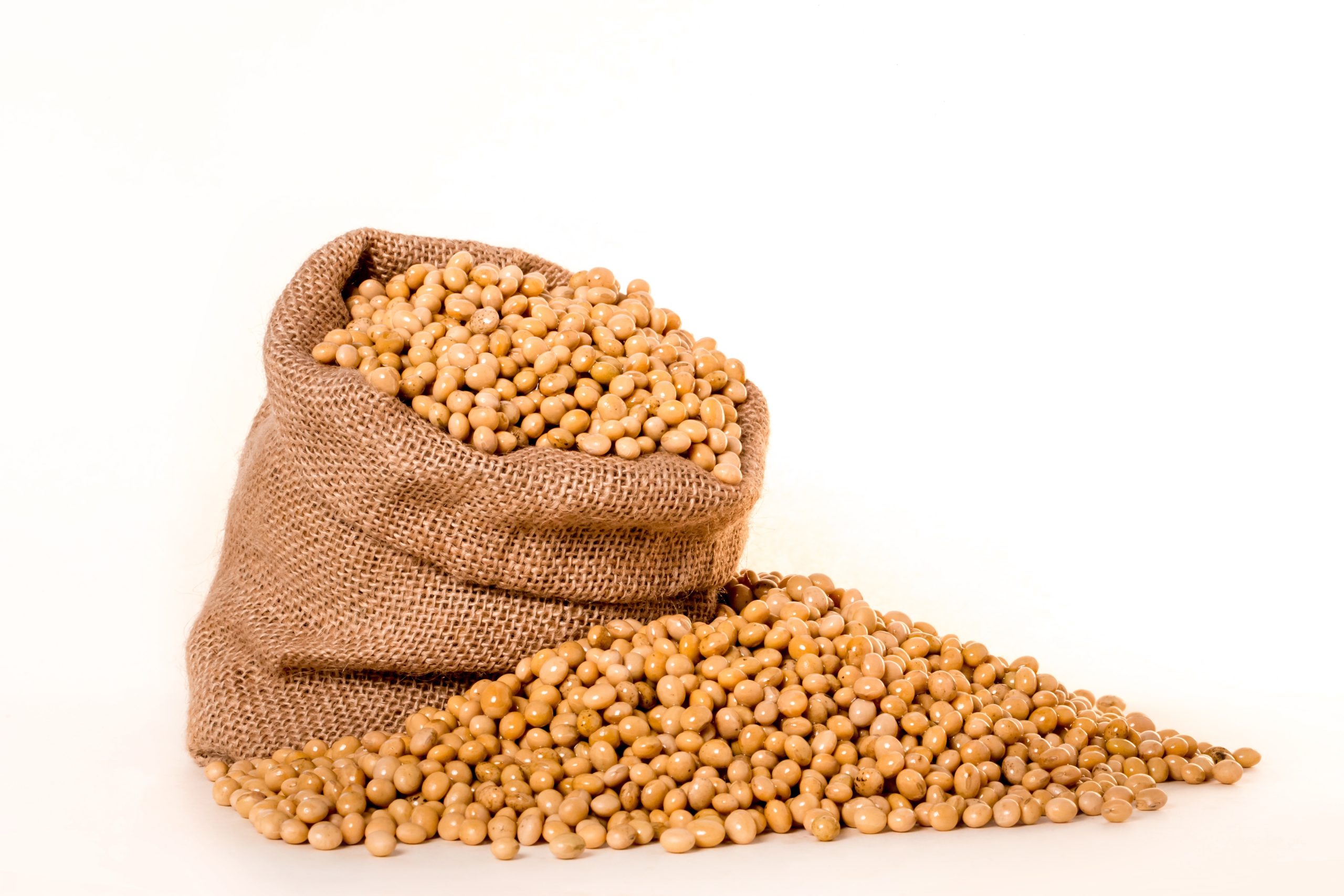Weeds are a hazard that requires diligence in soybean fields, Extension specialists say.
In the above photo, soybeans are shown in a bag and overflowing with credit to pnmralex at Pixabay.

Kevin Bradley, a state Extension weed scientist and education director for the University of Missouri, said in his state many corn growers are also soybean producers, so they are well aware of the weed problems each crop faces.
“Our No. 1 worst weed in the Midwest is waterhemp,” he said. “It has been for some time and likely will be for some time to come. In the South, that changes to Palmer amaranth. In the Western corn belt, kochia is also a concern.”
Regardless of the crop, combating weeds is necessary.
“There are some obvious problems that may be present in fields that were intended for corn and had a fall herbicide application that only allows for corn in the rotation the next year,” he said.
Bradley writes for Mizzou Crop and Post News about the topics. As thinks about “soybean on soybean rotation” one concern is it puts a greater pressure on post-emergence herbicide and greater likelihood of resistance development.

Sarah Lancaster, an assistant professor and Extension specialist in weed science at Kansas State University, said growers should first think about what herbicides had been applied in the summer or fall of 2023 and if carryover injury might be a concern.
“The second thing to think about would be which herbicide-resistant trait to choose,” she said. “The most common ones in the marketplace are Enlist E3 or XtendFlex. I’m starting to hear some concerns about the availability of over-the-top dicamba formulations for the XtendFlex system, so I would encourage anyone interested in that system to contact their input providers as soon as practical.”
Treatments to consider
Bradley believes growers must rely on effective soil residual herbicide programs as much as possible. Currently soybean growers rely mostly on three active ingredients for post-emergence control of pigweed species—glufosinate, 2,4-D and dicamba.
If the Environmental Protection Agency does not allow dicamba application in 2025 it could make a difference on how soybean acres are allocated.
“I believe it would change the percentage of acres that get planted with XtendFlex soybeans quite a bit,” he said. “I would expect much more Enlist soybeans would get planted, and much more glufosinate and 2,4-D would get sprayed.”
Lancaster said one of the most important herbicide considerations for soybeans or corn is to use an effective and aggressive residual herbicide program. That starts with the burndown application. With the assumption that most soybean are going to be in a reduced tillage system, an early application to burndown emerged weeds should include herbicides like glyphosate, 2-4-D and dicamba.
A residual product like flumioxazin (Valor and similar products) or metribuzin (Tricor and similar products) can be helpful to prevent the emergence of new weeds, she said. Adding a contact herbicide like Sharpen or Reviton can help control difficult weeds like marestail, also known as horseweed.
Planting time
At planting, apply residual herbicides from at least two herbicide groups at full rates, Lancaster said. For Palmer amaranth and waterhemp, options include Group 15 herbicides like S-metolacher (Dual), acetocholor (Warrant), dimethenamid-P (Outlook) or pyroxasulfone (Zidua and Anthem) and Group 14 herbicides like flumioxazin (Valor) or sulfantrazone (Spart). Metribuzin (Group 5) is also an option.
“Be aware of maximum annual rates for products that are used in both the burndown and at planting application,” Lancaster said.
In season, the options depend on the herbicide-resistant trait that is chosen, she said. Regardless of the herbicide, timely application is the key to success. In the Enlist system, some of the best postemergence treatments for pigweed control include Enlist One in combination with Liberty. Glyphosate can be added for grass control, but avoid a Group 1 herbicide like clethodim (Select Max) or quizalofop (Assure II) because of concerns with angagonism.
In the XtendFlex system, Liberty remains a useful product; however, it cannot be tank mixed with XtendiMax, Engenina or Tavium, she said. Group 14 herbicides such as fomesafen (Reflex) can be mixed with dicamba products, but it is important that they be applied to small weeds (less than 4 inches) for a successful application.
An additional application of a Group 15 herbicide is also recommended with this application, Lancaster said. “Using one of these products is especially helpful if the soybean canopy is slow to close.”

Dylan Mangel, an assistant professor and Extension plant pathologist at the University of Nebraska-Lincoln, said if a grower has followed a soybean crop and plans to plant that field again with soybeans, he needs to control winter annual weed hosts of soybean cyst nematodes. Some weeds that host SCN include purple deadnettle, henbit and field pennycross.
Growers should take into account future crops as part of their management strategy, Lancaster said. It may seem like weed management ends when the crop is mature, but During the fall it is important to keep notes of weed escapes.
“Stopping seed production by weed escapes is a key step in slowing the spread of herbicide resistance,” Lancaster said. “Consider what options work for your fields—a fall herbicide application, mechanical control or something else. At the very least, be prepared to increase next year’s weed management efforts in fields with a large number of escapes.”
Bradley said while it is a long way before harvest this fall and looking ahead to the 2025 crop, growers need to be thinking about whether to apply a fall herbicide treatment after the harvest.
Other matters
The weed specialists believe that growers will continue to have a long-term commitment to soybeans. Plant breeders are continuing to research drought tolerance.
“It is a very active area of research, and I expect that to continue,” Bradley said.
Lancaster said the crop’s ability to tolerate weather extremes will be important for economic stability for the ag industry.
Mangel hopes to see soybean genetics continue to improve, particularly as growers seek better control over soybean cyst nematodes.
“Breeding takes time with SCN, for example. There are still a lot of good SCN resistance sources in the breeding pipeline. These will take time to make it into commercial varieties, but they will help when they do.”
Dave Bergmeier can be reached at 620-227-1822 or [email protected].
Soybean cyst nematode a menace
By Dave Bergmeier
There are few acronyms that draw the ire of soybean farmers like SCN, which means soybean cyst nematode.
SCN is a parasite and can cause significant yield loss, said Dylan Mangel, an assistant professor and Extension plant pathologist at the University of Nebraska-Lincoln. In many cases, yield loss can occur with no noticeable above-ground symptoms.
“The first step in SCN control is to determine where you have it so you can limit its spread,” he said. “SCN moves with soil, so don’t ‘traffic’ soil from infested fields to clean fields. To manage SCN once you have it afield, the first step is to rotate it to a non-host crop like corn. A single year out of soybean (production) will keep levels down.”
However, he said, “Additional years in corn will have diminishing returns.”
The second management step is to rotate resistant varieties, Mangel said. Peking and P188788 are the two most common resistance sources available.
The nematodes have been documented to evolve to overcome resistance sources. To help maintain the effectiveness, growers should rotate to a different resistance source each time they plant soybeans.
The third management option is to consider the use of nematode protectant seed treatment, Mangel said. To help test, the Nebraska Soybean Board supports free SCN testing for any Nebraska growers. For more information, visit go.unl.edu/scnsample.
Sarah Lancaster, an assistant professor and Extension specialist in seed science at Kansas State University, said SCN is an important topic for K-State’s row crop pathologist Rodrigo Onofre.
“It seems there are ‘hot spots’ around the state, and as soybean acres expand to the west, education is a consistent need,” Lancaster said. “One weed-related thought is that controlling winter weeds can be important to reduce host plants, and thus SCN populations in a field.”
Kevin Bradley, a state Extension weed scientist and education director for the University of Missouri, said there are cases of SCN in his state, so it is something that has to be monitored by growers there, too.
Dave Bergmeier can be reached at 620-227-1822 or [email protected].
Opportunities abound for soybean farmers
By Dave Bergmeier
Many experts believe soybean acres are likely to increase in 2024 because of higher input costs for corn and market opportunities.
Naomi Blohm, a market analyst with Total Market Farm Marketing and regular contributor to High Plains Journal, expects planted soybean acres will be higher than one year ago. The March 28 Prospective Planting report will give a clearer picture on the expected soybean acres planted this spring. The pre-report estimates are coming in at nearly 86.5 million acres, suggesting acres planted will be nearly 3 million more than a year ago.
In 2023, United States farmers planted 83.6 million acres of soybeans.
“The reason is multi-factored; part of crop rotation, part of lower corn prices being unattractive, and geographically, some Midwest locations have new or expanding crush plants, which lend to better local demand and potentially better basis received for soybeans,” Blohm said.
Her advice to farmers is to know their local market and watch cash and basis levels to lock on opportune prices as they may occur.
“Also, be aware of soybean price seasonals, which suggest that oftentimes the best opportunities to forward contract your crop is in Mid-May to Mid-June (for what a grower might be delivering at harvest),” Blohm said. “It can be hard for producers to pull the trigger during that timeframe as they may still be busy with planting or concerned about the newly planted crop growing in the field.”
Dave Bergmeier can be reached at 620-227-1822 or [email protected].




